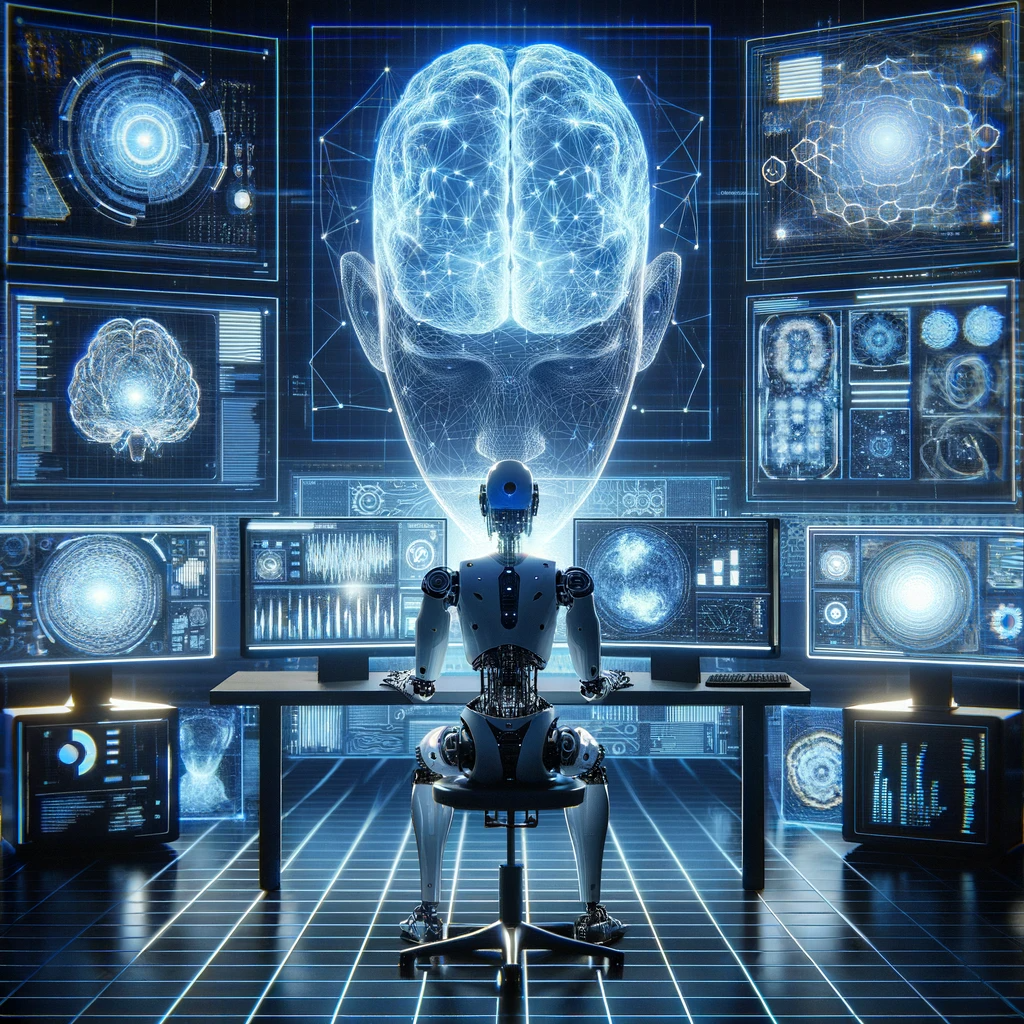MIT Technology Review by Amy Nordrum — No one can predict the future, but here at MIT Technology Review we spend much of our time thinking about what it might hold. One thing we know is that it’s especially hard to make predictions about technology. Most emerging technologies fizzle or flame out. Some start out as consumer devices but wind up finding their niche in more specialized applications. Only a few become household names. Each year, we put together a list of 10 Breakthrough Technologies, picking the advances that we think have the greatest potential to change our lives (for better or worse). We’ve done this for more than 20 years, and next month we’ll reveal our picks for the 2024 list. We haven’t always been right (RIP, Baxter), but we’ve often been early to spot important areas of progress (we put natural-language processing on our very first list in 2001; today this technology underpins large language models and generative AI tools like ChatGPT). Every year, our reporters and editors nominate technologies that they think deserve a spot, and we spend weeks debating which ones should make the cut. Here are some of the technologies we didn’t pick this time—and why we’ve left them off, for now.
New drugs for Alzheimer’s disease
Alzmeiher’s patients have long lacked treatment options. Several new drugs have now been proved to slow cognitive decline, albeit modestly, by clearing out harmful plaques in the brain. In July, the FDA approved Leqembi by Eisai and Biogen, and Eli Lilly’s donanemab could soon be next. But the drugs come with serious side effects, including brain swelling and bleeding, which can be fatal in some cases. Plus, they’re hard to administer—patients receive doses via an IV and must receive regular MRIs to check for brain swelling. These drawbacks gave us pause.

by dzone — Pryanka Pathak ·– Converges Artificial Intelligence (AI) and Natural Language Processing (NLP) to create wonders of language understanding and generation. In the era of AI-driven advancements, LLM technology has emerged as the hero of language comprehension and communication.
Introduction to LLM Technology
You might have heard whispers of “LLM technology ai” or “LLM tech” echoing through tech forums and AI discussions. But what exactly is it, and why should you care?
Well, you are about to find out the workings of these language giants, uncover their real-world applications, and explore the promises they bring to the future of the tech landscape.
By the end of this blog piece, you will not only understand what LLM technology is but also appreciate its significance in shaping the future of AI and NLP.

By ABC — Four Republican presidential candidates took the stage in Alabama on Wednesday night for one last chance to trade attacks and stake out policy positions before voting starts in the 2024 primary, in Iowa and New Hampshire, next month. The debate, the smallest yet, featured former U.N. ambassador Nikki Haley, Florida Gov. Ron DeSantis, former New Jersey Gov. Chris Christie and tech entrepreneur Vivek Ramaswamy. Knives seemed to be out for Haley amid her continued rise in the primary polls. She and DeSantis stood center stage as they vied for a distant second place spot to former President Donald Trump — who once again skipped sparring with his challengers, spending the night fundraising in Florida instead as he remains the polling front-runner. On the sidelines of the stage, Christie took on Trump while Ramaswamy took on everyone else. Here are five takeaways from the latest Republican debate.
Haley takes brunt of attacks
Haley, who has earned high marks in past debates, according to polling, was the main target of the attacks on Wednesday night. From the start, Ramaswamy and DeSantis took on the former ambassador for her stance on China, social media, transgender rights and more. “She caves any time the left comes after her,” DeSantis said as he slammed her record. “Any time the media comes after her.” Haley responded: “I love all of the attention fellas.”

By Jimi Olagher — MIT Review — On a picturesque fall day a few years ago, I opened the mailbox and took out an envelope as thick as a Bible that would change my life. The package was from Vertex Pharmaceuticals, and it contained a consent form to participate in a clinical trial for a new gene-editing drug to treat sickle cell disease. A week prior, my wife and I had talked on the phone with Haydar Frangoul, an oncologist and hematologist in Nashville, Tennessee, and the lead researcher of the trial.
He gave us an overview of what the trial entailed and how the early participants were faring. Before we knew it, my wife and I were flying to the study site in Nashville to enroll me and begin treatment. At the time, she was pregnant with our first child. I’d lived with sickle cell my whole life—experiencing chronic pain, organ damage, and hopelessness. To me, this opportunity meant finally taking control of my life and having the opportunity to be a present father. The drug I received, called exa-cel, could soon become the first CRISPR-based treatment to win approval from the US Food and Drug Administration, following the UK’s approval in mid-November. I’m one of only a few dozen patients who have ever taken it. In late October, I testified in favor of approval to the FDA’s advisory group as it met to evaluate the evidence. The agency will make its decision about exa-cel no later than December 8.

by Katyanna Quach — theregister.com — Startup Absci will turn to its generative AI algorithms to design synthetic protein
Pharma giant AstraZeneca has signed a $247 million deal with Ai drug creation company Absci to develop an antibody designed to fight cancer. The collaboration was announced on Monday and will see Absci deliver an antibody for a “specified oncology target”. AstraZeneca will cover its R&D efforts, while Absci will make a cut from royalty fees from any future sales if the drug makes it to market. “Absci’s newest partnership with AstraZeneca is further validation of our first-of-its-kind zero-shot generative AI model designed to create new and improved antibody therapeutics, including for previously untreatable diseases,” Absci CEO Sean McClain told The Register in a statement. “We’re proud to work closely with AstraZeneca to leverage our AI to bring novel treatments to oncology patients,” he added.
Can AI transformer models help design drugs and treat incurable diseases?
Chan Zuckerberg org to spin up 1,000+ H100 GPU cluster for AI medical research Former infosec COO pleads guilty to attacking hospitals to drum up business An Absci representative declined to detail which cancer the antibody will targeting, and when it expected to deliver a candidate to AstraZeneca. Absci’s drug design platform uses computational techniques, including generative AI models, to create millions of potential synthetic antibodies. The most promising designs are grown from genetically engineered E coli bacteria cells. The synthetic antibodies designed by AI can be made by altering the DNA of the E coli cells, forcing them to create the desired protein structure. The resulting creations’ abilities to effectively bind to targets can then be tested in lab experiments, and the data used to further improve the model’s future outputs. Joshua Meier, Absci’s chief AI officer, previously told The Register that there are more possible antibody variants that can be simulated than there are atoms in the universe. To find the most promising candidates, the company trains AI algorithms to predict various traits that suggest they might be more effective at things like marking cancerous cells for the immune system to attack, or preventing tumors from growing.

Robert Frank — cnbc.com — In recent months, the world’s new billionaires made more of their fortunes from inheritance than from entrepreneurship, according to the UBS Billionaire Ambitions Report. It marked the first time in the nine-year history of the report that newly minted billionaires accumulated more wealth from inheritance than starting a business. Fifty-three heirs inherited a total of $150.8 billion in the 12 months ending in April, exceeding the total of $140.7 billion accumulated by 84 new self-made billionaires, according to the Swiss bank’s report. The shift is likely to continue: The report said more than 1,000 billionaires are expected to pass $5.2 trillion to their children over the next 20 or 30 years. “The great wealth transfer, which we’ve all been talking about for the last 10 years, is underway,” said John Mathews, head of UBS’ Private Wealth Management division. “The average age of the world’s billionaires is almost 69 right now. So this whole transition or wealth handover will start to accelerate.”
Many billionaires will leave the bulk of their wealth to charity. And some, like Amazon founder Jeff Bezos, continue spending their fortunes on real estate, yachts and flights to space. Yet today’s billionaires will still have plenty to leave to their families. According to the report, the number of billionaires rose by 7% globally over the 12 months ending in April. The population of billionaires in the world increased to 2,544 from 2,376. Their total wealth great by 9% — from $11 trillion to $12 trillion. The great wealth transfer from billionaires and multi-millionaires will likely change the landscape in investing and wealth management, as well as spending and philanthropy. More than two thirds of the billionaires with inherited wealth in the UBS survey said that they plan to continue and grow what their parents or grandparents achieved – whether it’s in a business, a brand or assets. Yet their values and priorities may be different. The next generation of billionaire investors tend to be highly focused on climate change, technology and impact investing than older generations, according to studies.
by Katyanna Quach – the register — The council of Porto Alegre, a city in southern Brazil, has approved legislation drafted by ChatGPT. The ordinance is supposed to prevent the city from charging taxpayers to replace any water meters stolen by thieves. A vote from 36 members of the council unanimously passed the proposal, which […]

MIT Technology Review by Melissa Heikkilä — Each time you use AI to generate an image, write an email, or ask a chatbot a question, it comes at a cost to the planet. In fact, generating an image using a powerful AI model takes as much energy as fully charging your smartphone, according to a new study by researchers at the AI startup Hugging Face and Carnegie Mellon University. However, they found that using an AI model to generate text is significantly less energy-intensive. Creating text 1,000 times only uses as much energy as 16% of a full smartphone charge. Their work, which is yet to be peer reviewed, shows that while training massive AI models is incredibly energy intensive, it’s only one part of the puzzle. Most of their carbon footprint comes from their actual use.
The study is the first time researchers have calculated the carbon emissions caused by using an AI model for different tasks, says Sasha Luccioni, an AI researcher at Hugging Face who led the work. She hopes understanding these emissions could help us make informed decisions about how to use AI in a more planet-friendly way. Luccioni and her team looked at the emissions associated with 10 popular AI tasks on the Hugging Face platform, such as question answering, text generation, image classification, captioning, and image generation. They ran the experiments on 88 different models. For each of the tasks, such as text generation, Luccioni ran 1,000 prompts, and measured the energy used with a tool she developed called Code Carbon. Code Carbon makes these calculations by looking at the en

by Daniel Howley· Yahoo Technology Editor — It’s been quite a year for OpenAI. In the last few weeks alone, the company survived an attempted coup in which co-founder and CEO Sam Altman was fired and then rehired following pushback from employees and big-name investors like Microsoft (MSFT). And that’s not even the most interesting part of the story. Exactly one year ago tomorrow, OpenAI’s generative AI-powered ChatGPT hit the web, quickly becoming one of the fastest growing apps in history and setting off an AI gold rush that continues to reverberate across the technology industry and beyond. Companies ranging from Google (GOOG, GOOGL) and Microsoft, an OpenAI investor, to Amazon (AMZN), Meta (META), and others are racing to build out their own generative AI-powered software platforms.
On the hardware front, the AI explosion has made Nvidia, the world’s leading AI chip developer, the hottest semiconductor company on Earth, again. Year to date, shares of Nvidia are up more than 200%. Intel (INTC) and AMD (AMD), meanwhile, are up 67% and 90%, respectively. “We all understand ChatGPT was a critical inflection point in the history of AI, in spite of the fact that it’s only a year out since its initial release,” Rishi Bommasani, the society lead at Stanford’s Center for Research on Foundation Models, told Yahoo Finance. But ChatGPT, and generative AI more generally, have raised questions about data usage rights and the potential to create and spread disinformation via images and videos. “While [generative AI] tools are empowering us in so many ways, with so many kinds of superpowers, it’s interesting to consider that the same tools can also apply to what supervillains want to do,” explained Daniela Rus, director of the Computer Science and Artificial Intelligence Laboratory (CSAIL) at MIT. “And so we have to think about what guardrails we need to put in place before we deploy the tools so that we ensure that the use is a good one.”



